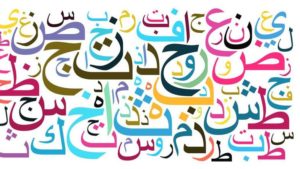Use the Best Way to Learn Arabic
Arabic is a beautiful and rich language. But, learning it can seem daunting. Luckily, there’s an easy way to master it. You can reach fluency in Arabic in record time if you follow these 10 steps. This advice won’t just teach you how to learn Arabic. It also gives you the best way to reach Arabic fluency.
There are over 270 million Arabic speakers worldwide. With its global importance, Arabic is definitely worth learning. And if you’re passionate about the language, the people, and the culture, you can use that to get to fluency even faster.
How Long Does It Take to Learn Arabic?
There’s no universal number for how long it takes to learn a language. But, we can give you an rough estimate if you’d like. The US Foreign Service Institute (FSI) came up with an estimate for how long it takes to learn Arabic for native English speakers. According to them, you need 2200 hours or 88 weeks to reach Arabic fluency. But, take this with a grain of salt.
This scale takes into account the difficulty of the language compared to English. But, it doesn’t know your motivation, enthusiasm, or what kind of language learning method you use. All of these influence how long it will take you to learn Arabic. And with these tips, it will definitely take you less time to reach Arabic fluency.

Before You Begin Learning Arabic
I know, you’re eager to get started. But, if you’re well prepared for the journey, you’ll be better off in the long run. You’ll ensure that you have a steady and prosperous language learning experience. And, you can also shave off a couple of weeks/months from the FSI estimates.
1. Define Your Goals and Motivation
Everybody learns a language for a reason. What’s your reason? Do you want to travel to an Arabic speaking country? Are you just fascinated with the culture? Or perhaps you aspire to read the Qur’an? Keeping your motivation in mind can help carry you through to Arabic fluency.
Starting from your motivation, you can easily figure out what level of Arabic you’d like to achieve. This is how you adjust your goal to the best way to learn Arabic for you. If you’re learning for travel, you should stick to travel phrases. But, if you’d like to fluently have a conversation in Arabic, you need a little bit more effort.
2. Create a Language-Learning Schedule
The best way to prepare for learning Arabic is create a language learning schedule. Plan your journey step by step to know when you’ll reach Arabic fluency. This is a great trick to maximize your success.
Don’t worry about fitting in learning Arabic to your schedule. Finding hours in your busy day seems impossible. But, you actually only need 20 minutes each day. And it doesn’t even have to be 20 minutes of intensive study. You can practice on your commute, in the gym, or while you’re cleaning.
When you have your schedule, you’ll need to stick with it. That how you can learn Arabic successfully.
3. Choose the Right Arabic Language Resources
The key to language learning success is having the right resources and study materials Specifically, these methods need to work for you. Everyone is different, so make sure you choose a resource that is tailored to you.
So, how do you know the learning method you chose is effective? Well, if you enjoy it and you feel like you’re progressing, you made the right choice. Having fun is the most important part of learning a language.
There are a lot of ways to learn Arabic. Some are free, and some can also be very expensive. In the end, if the method works for you, it will be worth the investment.

Common Arabic Learning Methods:
- Join an Arabic Class: Your local college or language school probably runs an Arabic course. You can sign up and study with a teacher and other learners like you. If you like the classroom environment, go for it. But, be aware that your classmates may slow down your progress. It’s not worth getting a lot of student debt for that.
- Hire a Private Arabic Tutor: A private tutor can give you the most tailored Arabic classes. These one-on-one sessions will focus on developing the part of Arabic fluency you struggle with the most. But, be prepared to pay for the time and expertise of your tutor. This is one of the most expensive ways to learn Arabic.
- Buy Arabic Textbooks: You can learn Arabic by yourself. You can reach fluency faster this way too. Invest in some Arabic textbooks to guide your home lessons. But, if textbooks are too boring or old-fashioned for you, don’t worry. There’s an even better way to learn Arabic.
- Use an Arabic Language Learning App: Apps are the best way to learn Arabic. They’re convenient, so you can learn from anywhere in the world. And they won’t hurt your wallet. But, be careful. Get an Arabic app that gets you to speak the language. Typing Arabic won’t get you any closer to fluency.
4. Focus on Comprehensible Input
The best way to learn Arabic is with comprehensible input. This is a language learning theory by Stephen Krashen. You can bring this technique to your lessons easily with two simple steps:
- Aim your study materials for a little bit higher than your current level.
- Make sure you understand everything from context.
This way you can learn Arabic effectively. If your lessons are too easy, you’ll get bored. If they’re too hard, you’ll give up. By reaching comprehensible input, you can make sure you’re engaged and enjoying your Arabic lessons.
The Best Way to Learn Arabic
I’m sure you’re itching to find out what specific steps you can take to learn Arabic. And without further ado, here they are. Keep in mind that Arabic is just like any other foreign language. You need to master Arabic grammar and vocabulary. But, most importantly, you need to speak it. That’s the fastest (and overall best) way to reach Arabic fluency.
1. Learn the Arabic Alphabet
This first step is crucial. You need to master the Arabic alphabet to read, write, and understand the language. Luckily, it isn’t as complicated as it seems.
There are 28 letters in the Arabic alphabet. All but one are consonants. This almost makes the Arabic alphabet an abjad, also known as a vowelless writing system. But, there is one vowel in the Arabic alphabet, so it’s actually only an impure abjad.
Arabic is written from right to left. Which may seem complicated at first, but you’ll get used to it very fast. Also, if you’re left-handed, it will definitely enjoy it.
Here are all 28 letters of the Arabic alphabet to get you started, along with their approximate pronunciation in English.
|
ا A Alif |
بB Ba |
تTTa |
ثThaTheh |
ج JJim |
حH Ha |
خKHKha |
|
دD Dal |
ذTHDhal |
رR Ra |
زZ Za |
سS Sin |
ش SH Shin |
ص S Sad |
|
ضDaD’ad |
طDHDha |
ظThaDh’a |
ع A ‘Ain |
غGH Ghain |
فF Feh |
قQ Qaf |
|
كK Kaf |
لL Lam |
مM Mim |
نN Nun |
هH Ha’a |
و W Waw |
يY Yah |
2. Learn Common Arabic Words and Phrases
Learning a foreign language is not about how many words you know. It’s about knowing the right words. Having the best vocabulary can give you a great advantage. You don’t waste time learning unnecessary words in Arabic, only the most crucial ones that everyday Arabic locals use.
But, you might think that’s still a lot of words. What if I told you that you actually only need 20% of Arabic vocabulary. That’s because that 20% makes up 80% of everyday Arabic speech. It’s called the Pareto Principle. Learn only the most important Arabic phrases, and reach fluency in record time.
Common Phrases in Arabic
Greetings
- Hello Mar’haba / Salaam مرحبا / سلام
- Good morning Sabah Al Kheyr صباح الخير
- Good evening Masa Al Kheyr مساء الخير
- Goodbye Ma’a salaama مع السلامة
- Hi Mar’haba / Salaam مرحبا / سلام
- Bye! Salaam سلام
- How are you? Keef Halak? كيف حالك؟
- (I’m) Fine, thanks (Ana) Bikheyr, Shukran (أنا) بخير، شكرا
- You are welcome Afwan عفواً
- My name is …… Ismii ….. / Ana Ismii…… إسمى ….. / أنا إسمى ……
Small Talk
- Yes Na’am /Aywah نعم / أيوة
- No La’a لا
- Ok Hasanan / ha’dir / Na’am حسنا / حاضر / نعم
- Please Min fadlik / Arjuuk من فضلك/ أرجوك
- Sorry Aasif آسف
- Excuse me low samaht لو سمحت
- I don’t know Ana la a’rif أنا لا أعرف
- I don’t understand Ana la afham أنا لا أفهم
- Could you repeat again? Mumkin ta’iid Taanii? ممكن تعيد ثانى؟
- I don’t speak Arabic Ana la atakalam al Arabiya أنا لا أتكلم العربية

3. Remember More With Spaced Repetition
Now that you’ve seen a couple of common phrases in Arabic, I bet you want to remember them all. Wouldn’t it be awesome if there was a way to hack your brain and store all that information in there easily? Well, it actually already exists. It’s called spaced repetition, and it’s the best way to learn Arabic in record time.
Your brain is always trying to forget. This psychological phenomenon is called the “Forgetting Curve”. And spaced repetition is the only way to combat it.
You can easily implement spaced repetition by periodically reviewing your material. A few days after your Arabic lesson, go back and reread it all. You’ll remember more and more as you review it repeatedly. Soon, all the information you want to know will be in your head.
4. Master Arabic Pronunciation
The Arabic language has a lot of unique sounds. These don’t exist in English, but you can learn them. There are a lot of tips for how to speak Arabic out there. But, there’s one ultimate advice: practice a lot.
Many language learners leave practicing their speaking skills last. Maybe they’re scared of embarrassing themselves. Or they’re unsure about how to pronounce Arabic words correctly. Don’t let language learning anxiety limit you. You need to start speaking from the first lesson to achieve fluency.
If you practice your speaking skills early, you’ll get comfortable faster. And once you reach that, there’s nothing stopping you. You can reach fluency fast and easily.
5. Surround Yourself With Arabic
The more you hear and practice Arabic, the faster you’ll reach fluency. However, traveling to an Arabic speaking country is a luxury for many of us. But, you can bring an immersion experience to you. Learn about Arabic culture, history, and society from the comfort of your home. These tips to learn Arabic aren’t just useful, they’re also really fun. Try a couple of these to enhance your Arabic knowledge:
- Watch Arabic YouTube: YouTube is great because it’s free. And there are plenty of Arabic YouTubers who can teach you the language. Listen to authentic Arabic online as you stream their videos.
- Listen to Arabic songs: music is great for language learning. You can hear the rhythm and melody of the language. And Arabic folk songs are especially lovely to listen to. Try to sing to combine listening with a speaking practice.
- Learn About Arabic Culture: Arabic culture deeply connected to Islam. This old and popular religion has plenty of traditions that are fascinating to learn about.
- Watch Arabic TV: Watching TV is extremely popular in Egypt. Try to tune into an authentic Arabic TV channel, and listen to locals and presenters speak the language.

6. The Best App to Learn Arabic
There are a lot of ways to learn Arabic. But, these steps are the ultimate guide to get you to fluency fast. And if you want to try an app that combines all this great advice, you need to download OptiLingo.
OptiLingo is a reliable app that’s based on the science of language learning. It gives you the most useful Arabic vocabulary, so you can learn exactly how the locals speak. OptiLingo also lets you listen to these phrases, and then it makes you repeat them, so you practice your reading, speaking, and listening skills at the same time. And best of all, OptiLingo has built-in spaced repetition. You’re guaranteed to remember your lessons. Achieve Arabic fluency easily when you download OptiLingo!









